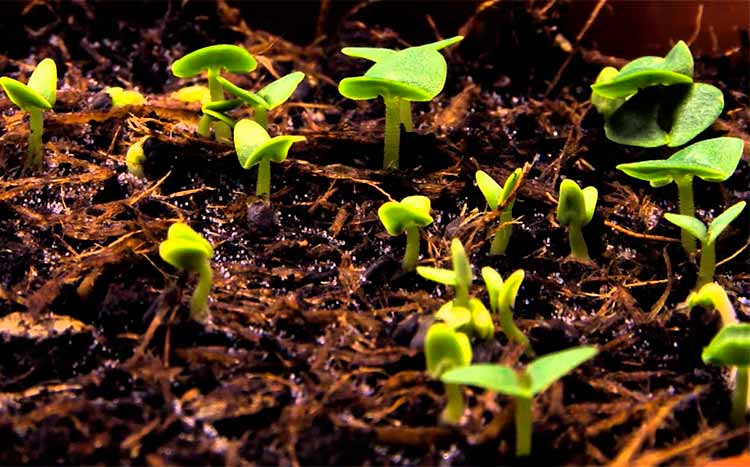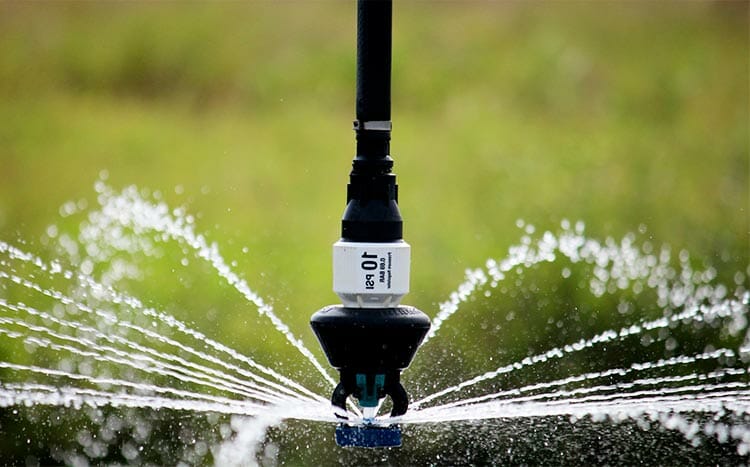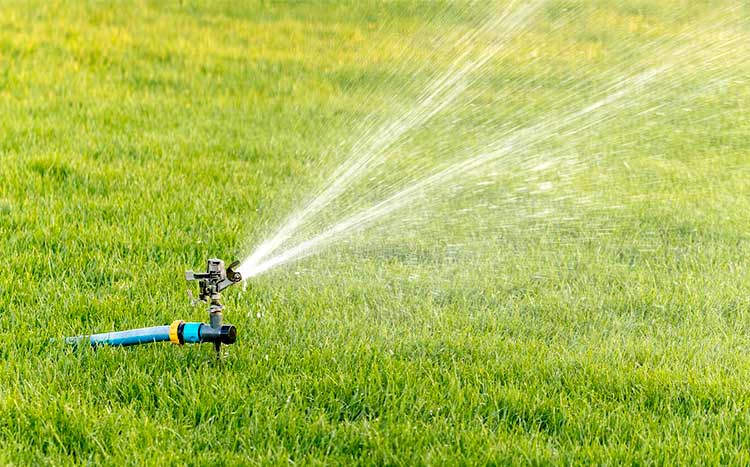A cost-efficient and highly efficient approach to establishing a lawn, hydroseeding is a well-liked option for homeowners. A common query is the expected timeline for seeing signs of growth after the application.
Hydroseed takes between 5 days and 30 days to germinate. Some grass types, like ryegrass, can germinate in as little as 5 days. While others, like Kentucky bluegrass and Bermudagrass, can take up to 30 days to germinate.
Since it usually takes about 4 weeks to 5 weeks before you can make the first cut, you should always walk carefully on the grass. This is because it can take up to 15 weeks for the lawn to be able to handle light traffic, and up to a year before it can comfortably handle heavy traffic.

What we cover
ToggleHow long before you can walk on hydroseed?
When watering the hydroseed, you can walk on it. However, you should always take care not to disturb the applied mulch mat. Doing so can lead to uneven growth, and may even affect the ability of some of the seeds to germinate.
Generally, you should protect the grass from any form of traffic, or even playing children, in the first 6 weeks. You may allow light traffic on the grass after about 10 weeks to 15 weeks. As for heavy traffic, it may be up to a year before your lawn becomes strong enough to handle it.
Why is my hydroseed not growing?
Your hydroseed may fail to grow properly because of a number of reasons. Here are the most common ones.
Lack of moisture
For hydroseed to grow properly, it needs to be watered between 2 to 4 times a day. The hotter and dryer the climate, the more times it needs to be watered.
This is because the water that is used to make the hydroseed mix is not enough to support germination and growth. Therefore, failing to keep your lawn moist at all times will deny the seeds the moisture that they need to grow.
They will dry out. And they will eventually die. This will lead to hydroseed failure.
Washouts
While hydroseed contains a binding agent that is meant to bind it to the soil and keep it from being blown away or washed off, extreme rainfall and winds can still wash the hydroseed off the applied area. This is so especially if it is applied on steep surfaces.
Washouts cause hydroseed failure. This is because there will be no seed to grow. A washout may also wash off fertilizer, mulch, and other additives that are meant to enhance growth. Therefore, the odds of hydroseed failure or poor growth increase after a washout.
If there is a washout, you may have to respray your lawn in order to get great results. Opting for hydroseed that has better binders, or adjusting your timing for hydroseeding, are also things that you may have to consider.
Lack of sunlight
If your hydroseed is in a shaded area, it will fail to generate thick, strong, and green grass blades. Instead, you will end up with spindly leaves that are long and unattractive.
Sunlight is necessary for food production. As a result, if your grass doesn’t get the quality and quantity of sunlight that it needs to thrive, it will end up with poor growth.
This will translate to a weak root system. And also result in weak grass blades that are extremely vulnerable to damage. And even grass that is susceptible to diseases like foliar disease.
Trauma from traffic
While you can walk on hydroseed when watering it, allowing even light foot traffic on your newly hydroseeded lawn is inadvisable. The trauma from the traffic is bound to disturb the hydroseed mulch mat. And it may then cause it to not grow properly.
To make sure that your hydroseed grows, you should protect it from traffic. This means blocking pets, children, and other people from walking on it. This is so especially during the first weeks of installing the new lawn.
Improper soil preparation
Poorly prepared soil increases the odds of washouts. It also prevents proper root development. And it increases the likelihood of your hydroseed not growing.
Will hydroseed grow without watering?
No, hydroseed will not grow properly without watering. The seeds need to be moist for there to be proper germination. And the water that is used in the application process is usually not enough to support germination and growth.
For the best hydroseeding results, you will need to water your hydroseed about two to four times a day. Each watering session should last about 15 minutes.
How often do you water hydroseed?
You should water hydroseed between 2 to 5 times a day. At worst, it should be at least once a day.
For dry climates, watering hydroseed at least twice a day is advisable. And if you are installing the lawn in extremely windy and dry conditions, you may have to water it up to 4 or 5 times a day.
What happens when hydroseed dries out?
When hydroseed dries out, grass seedlings die. This is because they need moisture in order to produce food and survive. As a result, drying will definitely lead to hydroseeding failure or poor and spotty growth at best.
Will rain wash away hydroseed?
Rain does not usually wash away hydroseed. Even in cases where the hydroseed dye seems to wash away.
This is because most hydroseed mixes contain binding agents. These agents bind the hydroseed to the soil. Therefore, they tend to be effective when it comes to preventing washouts — provided the soil has been properly prepared.
However, there is only so much that the binding agents can do in the face of heavy rainfall. Torrential rain can wash away hydroseed especially if it is applied on a sloped surface.

How do I prepare my lawn for hydroseeding?
To prepare your lawn for hydroseeding, you should do the following.
Remove debris
Start off by removing tree debris such as any sticks, leaves as well as rocks, and any other items that may be on the site. If the area has patches of grass or weeds, removing them is also necessary.
Till the soil
The next step is to then make the soil root-friendly. Tilling it to about 4 inches deep will make the soil less compacted. It will make it easier for the growing grass shoots to establish their roots. And this will increase the chances of ending up with green, strong, and healthy grass.
Eliminate weeds
Weeds will compete for nutrients with your grass. They will also reduce the aesthetic appeal of your lawn. This makes eliminating them an important step towards establishing a beautiful and healthy lawn.
Start the weed elimination process by encouraging them to grow. An effective way to do so is to both fertilize and water the soil. This will trigger growth even in dormant weed seeds.
After the weeds start showing signs of growth, apply a grass and fertilizer killer on the site. And then give the herbicide enough time to work — 2 days to 5 days will be enough.
Smoothen and level the soil
After the weeds have all been killed and you have given the soil some time to recover from the herbicide, you should re-grade the soil to make sure that it is loose enough to encourage proper growth. Do this a few days before applying the hydroseed.
Remove obstructions
The last step in the process is to clear the path for hydroseeding equipment. Anything that might hinder the movement of the equipment or the hydroseeding contractors should be removed or repositioned. This will help to save time, and it will make the entire process stress-free.
FAQ's
Fall and spring are the best times of the year to hydroseed. This is because they feature moderate temperatures that are ideal for seed germination and grass growth.
Spring temperatures are perfect for grass growth. This is because they create a warm soil environment that encourages root development.
Fall features moderate temperatures and precipitation. Hydroseeding in Fall, therefore, encourages faster growth as it guarantees moist conditions that are growth-friendly.
Winter and summer are bad periods for hydroseeding.
This is because they feature extreme weather. And whether it is winter cold or summer, neither is good for germination or seedling development.
Yes, you can hydroseed on your own. You can do so by renting a hydroseeding machine from a local store, making your hydroseed mixture, and then applying it. You can also buy hydroseeding starter kits online, and then use them to apply hydroseed on your property.
Hydroseeding costs(per square foot) range between $0.06 and 0.20. Therefore, given its efficiency, uniformity of results, and increased likelihood of ending up with a healthier lawn, it is totally worth it.
And while it does not give the instant gratification of laying sod, it is way more affordable than sod, something that makes it a more prudent and economical option.
Yes, hydroseed can be overwatered.
You should water hydroseed between 2 to 4 times a day, with each watering session lasting for about 15 minutes.
The goal should be to make the soil moist. Anything more than that will be overwatering, something that will cause your grass to develop weaker and shallower roots. It will also increase the likelihood of diseases.

If you need help installing a new lawn or taking care of an existing one, you should visit HomeGardenGuides.com. It offers a free service that quickly matches you with the top-voted local experts.
Using the website, you can get 3 estimates fast by real certified experts in your area in just 2 minutes. Here is how it works.
- You scroll to the top of the page and enter your Zip code.
- Answer questions about your lawn care needs
- Your details will be forwarded to three local experts.
- You will then receive a price estimate for the job and some friendly advice.
IMPORTANT: There is no obligation to hire. This is a free tool and service to be used at your pleasure.






